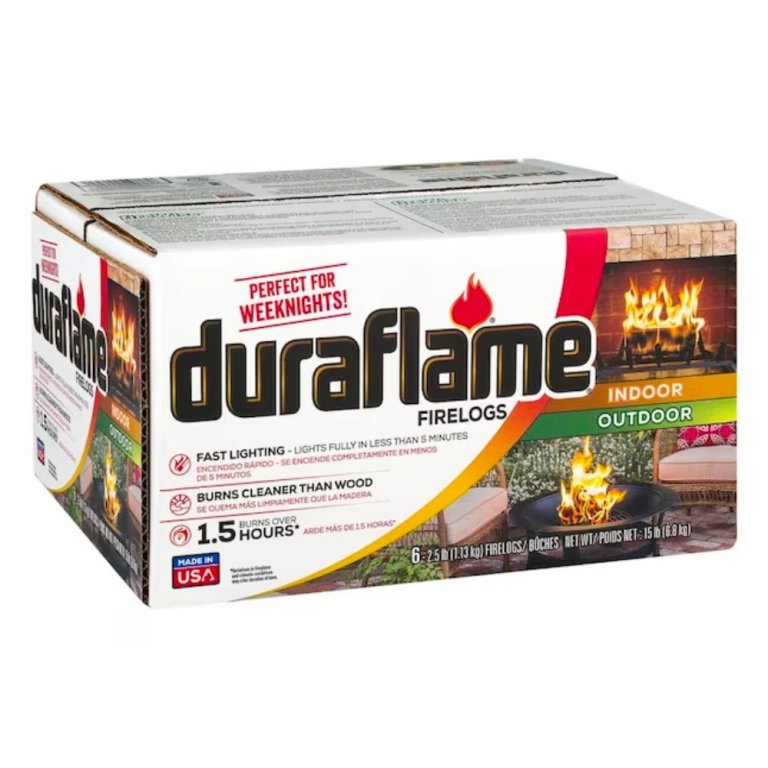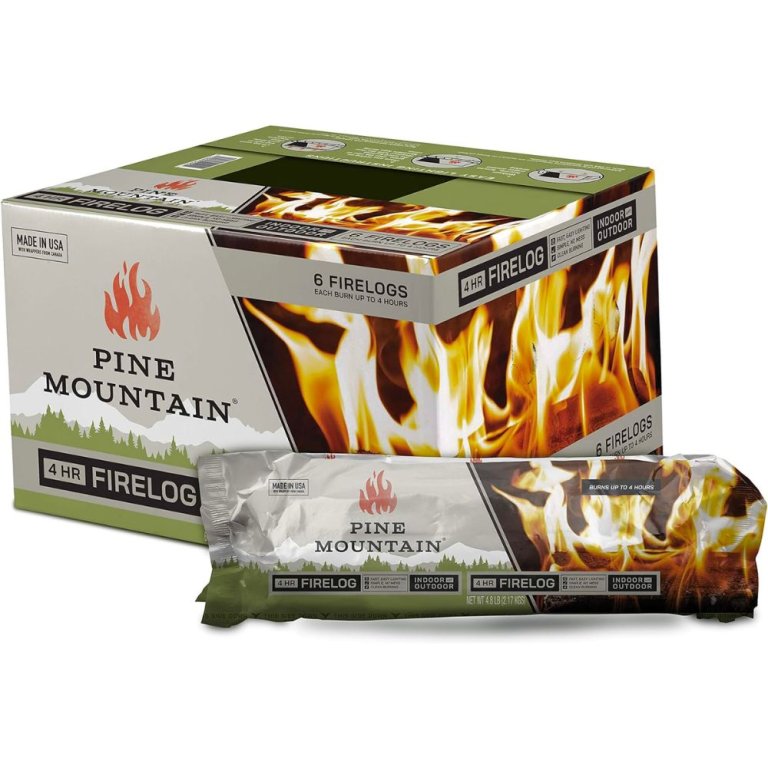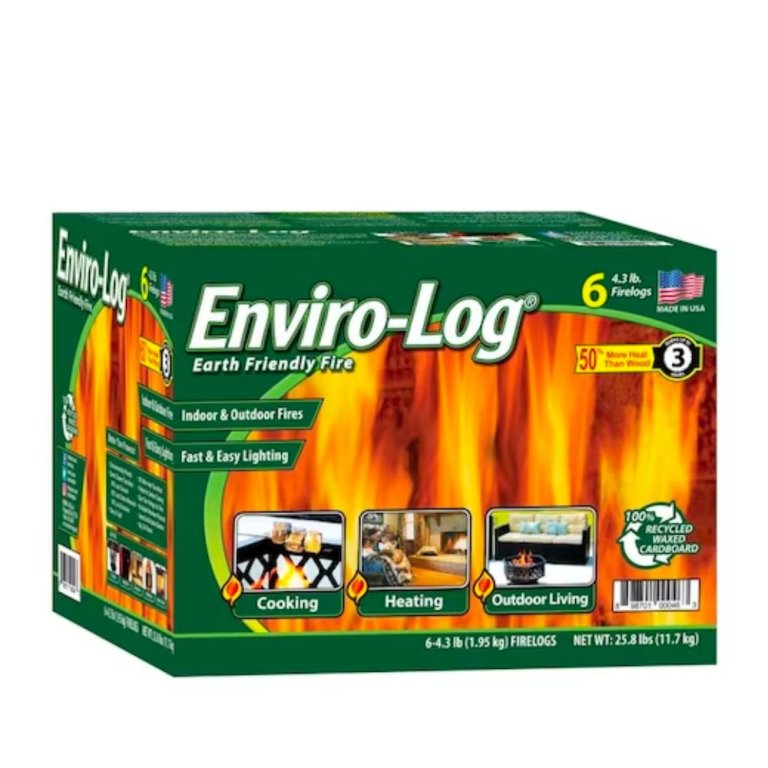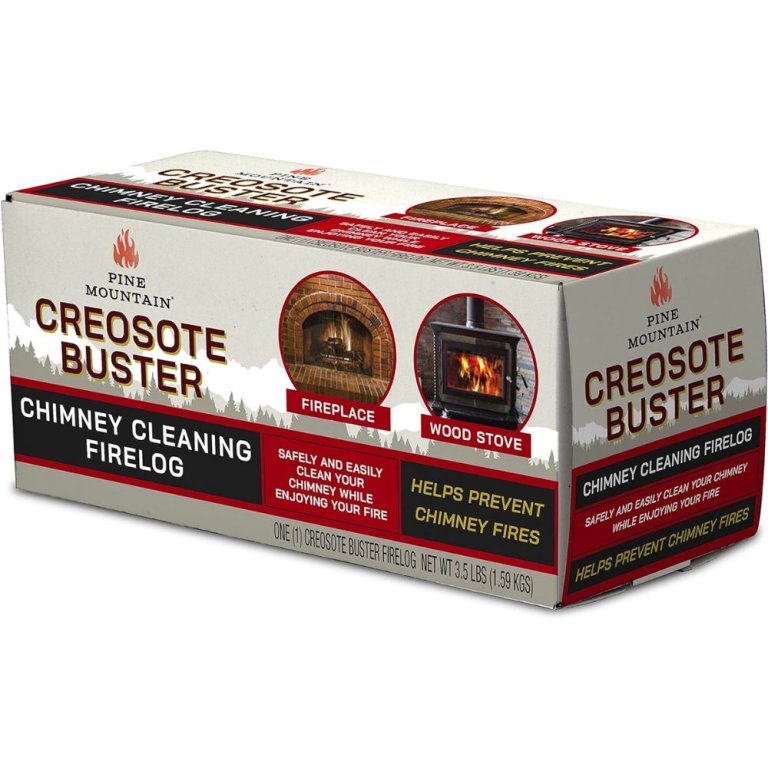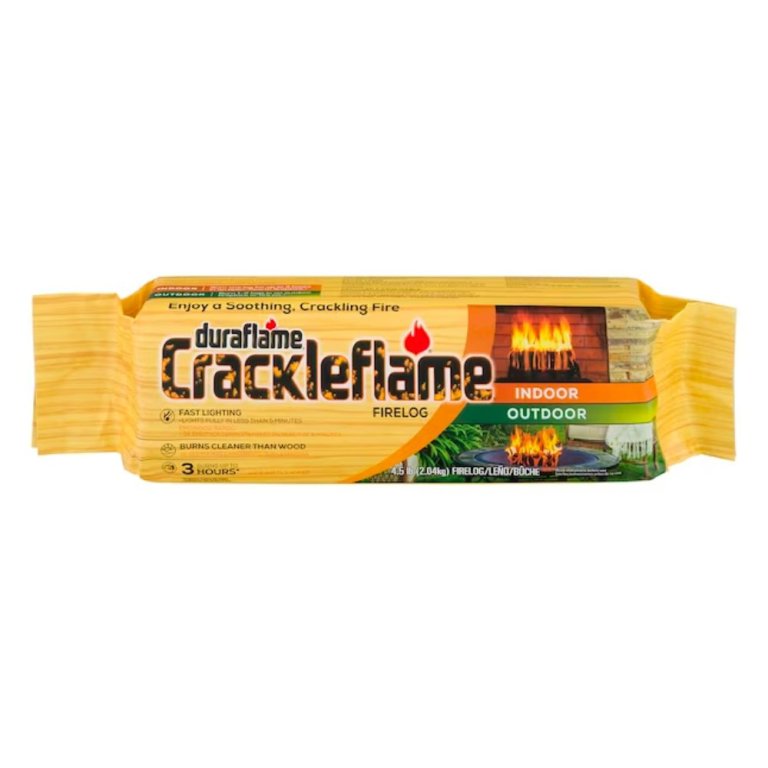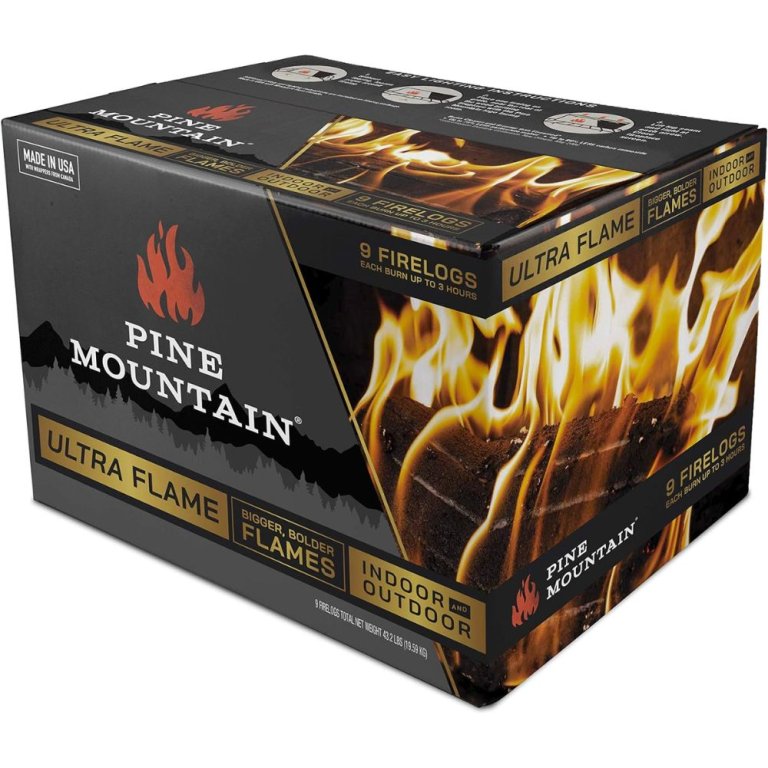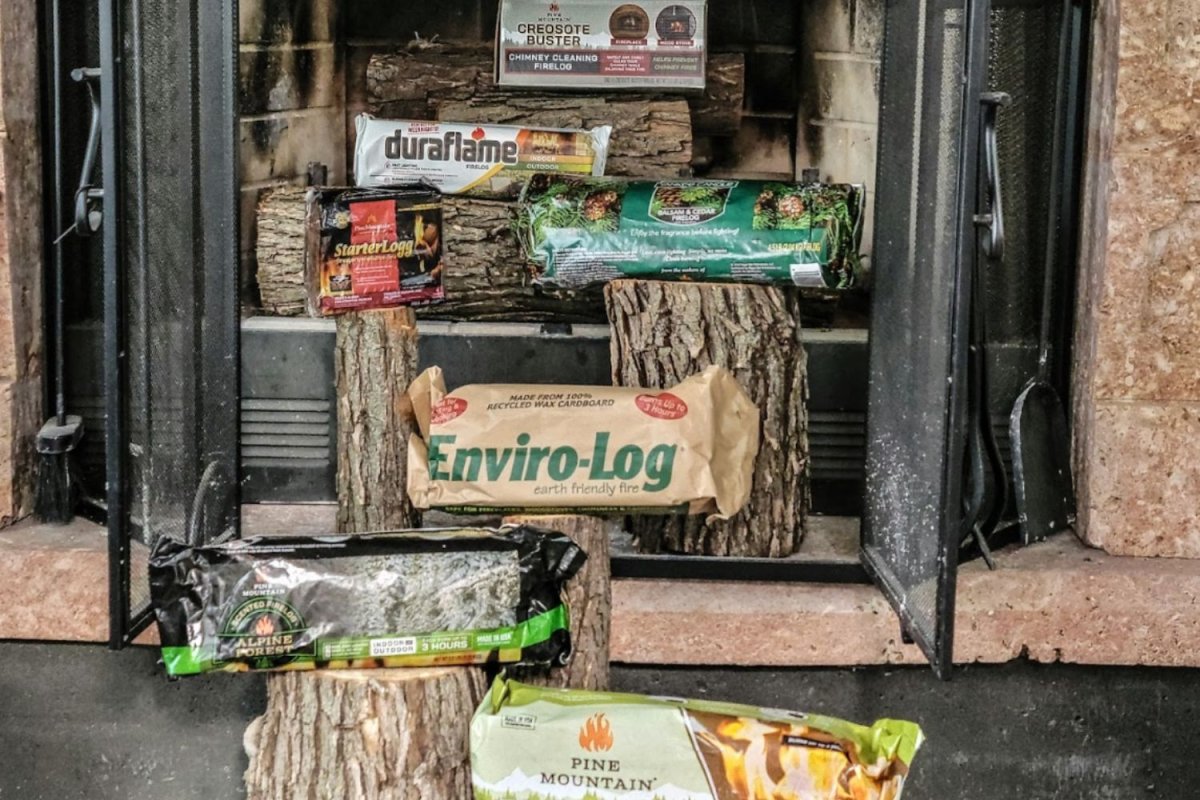
We may earn revenue from the products available on this page and participate in affiliate programs. Learn More ›
When outdoor temperatures drop and sweaters come out of storage, there’s nothing quite like the crackle of a real fire. It’s tough to beat the ambience, allure, and all-around warmth of a fire, whether it’s in a fireplace, a wood-burning stove, or a fire pit. Sourcing natural wood can be challenging, however, if you don’t live in an area where it’s plentiful. In addition, real wood logs can be heavy and difficult to light.
Enter fire logs. Made from compressed wood products such as sawdust and treated with waxes to light easily, fire logs will typically burn for 2 to 4 hours. While we like the recycling aspect of many fire logs—why cut down more trees when leftover wood products can be reused?—we weren’t sure if these products were all they’re cracked up to be, so we decided to test them. Over 3 weeks, we burned dozens of fire logs in fireplaces, chimineas, outdoor fire pits, and wood-burning stoves. Before buying, discover how the following brands earned a spot in this lineup of the best fire logsfor most fireplaces. Plus, find out the pros and cons we uncovered in our hands-on testing.
- BEST OVERALL: Duraflame Gold 4.5-Pound Fire Logs
- BEST BANG FOR THE BUCK: Duraflame 2.5-Pound Fire Logs
- BEST LONG-LASTING: Pine Mountain 4-Hour Fire Log
- ECO-FRIENDLY PICK: Enviro-Log 4.3-Pound Fire Logs
- BEST CREOSOTE REMOVAL: Pine Mountain Creosote Buster Fire Log
- BEST STARTER LOGS: Pine Mountain StarterLogg Firestarter
- BEST SOUND EFFECTS: Duraflame Crackleflame Fire Logs
- ALSO CONSIDER: Pine Mountain Ultra Flame Fire Log

How We Tested the Best Fire Logs
We researched dozens of fire logs in their respective categories before choosing the top performers (based on ratings) to test.
Most fire logson our list are advertised as producing fewer carbon monoxide emissions than traditional wood, thus reducing toxins in the home and limiting the amount of harmful smoke. These artificial logs come in various quantities and contain natural materials such as real hardwoods, waxes, biomass fiber, sawdust, molasses, shells, and nuts.
In actual testing, we burned the fire logs as instructed by the manufacturer, noting how easy they were to light, how long they burned, and how much real heat they produced. We noted any added scents and looked for chemical-type smells; however, none of the logs we tested emitted chemical smells. The exception in our testing was the Pine Mountain Creosote Buster fire log. We could not determine that it made much of a difference in the soot and creosote buildup in our fireplace chimney, so we noted how long it burned. In the final analysis, we had to base our awards for this product on former user ratings.
For each test or observation, we awarded points based on a rubric. The better the log performed, the more points it received. After testing, we added and averaged the points for each fire log and used the results to determine the best category for each one.

Our Top Picks
These fire logs earned a place on our list by being easy to light in our hands-on tests, burning uniformly, and burning as long as advertised by their manufacturer. Each product differs slightly—some burn longer, some add a pleasant scent, and some will help keep a chimney clean. At least one of these fire logs is likely to add some coziness to a cold winter’s night.
Best Overall
Duraflame Gold 4.5-Pound Fire Logs
What We Like
- Fully engulfed in less than 5 minutes
- Flames are brighter and larger than those of some competing brands
- Eco-friendly composition of wood, fibers, and wax
What We Don’t Like
- Visible soot residue in fireplace chase after burning
Product Specs
- Number of logs: 9
- Materials: Recycled wood, fibers, and wax
- Burn time: Up to 3 hours
This Bob Vila Approved product carries our brand’s highest level of recommendation.
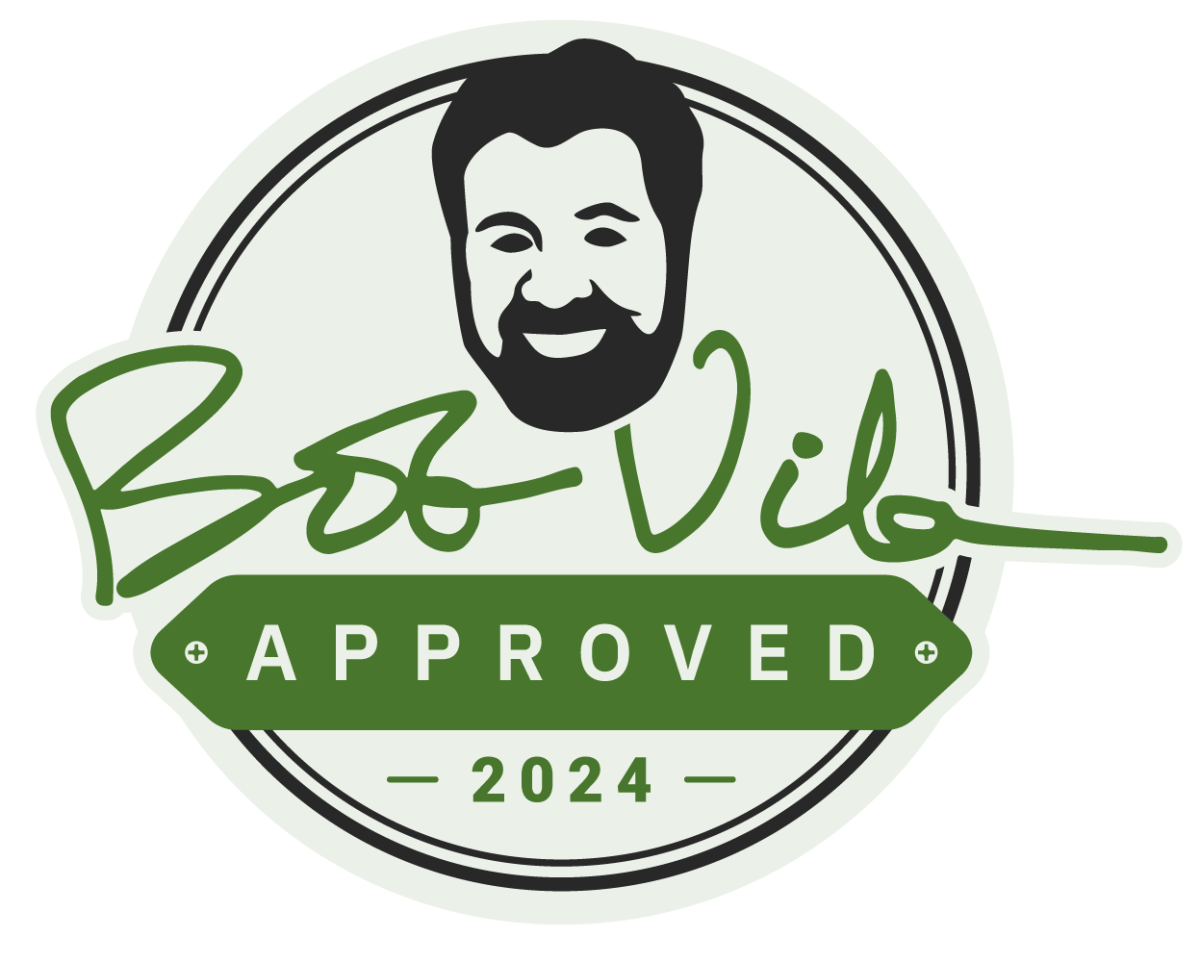
Bob Vila Approved recognizes the household and DIY products that impressed us most in our real-world testing and that exemplify core values of the Bob Vila brand, including craftsmanship, innovation, and value for the dollar. Winners of this designation come recommended by our professional review team and are personally approved by Bob Vila.
Our Ratings: Lighting Ease: 5/5, Burn Duration: 4/5, Warmth: 4/5, Eco-Friendliness: 4/5
The large, bright flames of the Duraflame Gold fire logs are just the thing to add cozy illumination to any room. We tested the fire logs in our fireplace and outdoor chiminea. These robust 4.5-pound fire logs were easy to light: We followed the instructions and lit the paper wrapper on both sides, and the entire log burned brightly within just a few minutes. It continued burning for an impressive 3 hours. We didn’t notice much warmth when we burned the Duraflame Gold log in the outdoor chiminea, but when we burned one in our she-shed fireplace, it raised the room temperature about 12 degrees in just an hour. Keep in mind that most fire logs are designed more for ambience than for heating a room, but they do typically emit some heat.
The Gold log didn’t produce any smoke as it burned, but a fine layer of soot emerged on the inside of our fireplace chase after we’d burned several of them. One of the nicest perks of this log is its eco-friendly ingredients, including recycled wood, fibers, and wax. We appreciated being able to enjoy the cozy feeling and light of a real fire without worrying about toxic chemicals.
Get the Duraflame Gold fire logs at Lowe’s, Amazon, Walmart, or Sam’s Club.
Best Bang For The Buck
Duraflame 2.5-Pound Fire Logs
What We Like
- Fully engulfed within 5 minutes
- Versatile; meant for both indoor and outdoor use
- Produces tall, transparent flames that create a mesmerizing visual experience
What We Don’t Like
- Smaller in size than comparable products, which may make them seem diminutive in large fireboxes
- Less burn timethan comparable products, so they may require more frequent replacement
Product Specs
- Number of logs: 6
- Materials: Sawdust, wax, and fibers
- Burn time: 1.5 hours (nearly 2 hours in testing)
Our Ratings: Lighting Ease: 5/5, Burn Duration: 3/5, Warmth: 3/5, Eco-Friendliness: 4/5
Duraflame produces a wide range of fireplace products, including these 2.5-pound fire logs, which are about half the size of some of the other products we tested. We burned this log in an old wood-burning stove that we use to heat a large shop. It was easy to light by following the instructions, which were nothing more than folding out the seam on the paper wrapper and then lighting it along the seam using a single match.
The entire log was on fire within 5 minutes, and it burned for just over 1 hour. Duraflame advertises a burn time of at least 1.5 hours, so we were slightly disappointed but also wondered if it might have burned faster because we burned it along with other small wood logs. We retested with only the Duraflame log, and it burned for nearly 2 hours. While these Duraflame fire logs are smaller than other products, they create a soothing fire with very little smoke. Plus, we estimated that the temperature in the shop went up about 10 degrees during the testing process.
Get the Duraflame 2.5-pound fire logs at Lowe’sor Walmart.
Best Long-Lasting
Pine Mountain 4-Hour Fire Log
What We Like
- Provides extended burning duration; suitable for prolonged enjoyment
- Consistent and uniform burning pattern; delivers a steady source of heat and light
- Eco-friendly composition promotes sustainability and reduces ecological impact
What We Don’t Like
- Higher price point compared to similar products
Product Specs
- Number of logs: 6
- Materials: Recycled hardwood, molasses, shells, and nuts
- Burn time: 4 hours (5 hours in testing)
Our Ratings: Lighting Ease: 5/5, Burn Duration: 5/5, Warmth: 4/5, Eco-Friendliness: 5/5
Shoppers whose goal is to hang out in front of the fire for an extended period might find the Pine Mountain 4-hour fire log to be just the ticket. The manufacturer advertises a 4-hour burn time, which is longer than many other artificial fire logs. In our testing, the log exceeded expectations and burned for nearly 5 hours, although the flames were pretty small during the final 30 minutes. As with the other fire logs, we followed the instructions and lit the paper wrapper. Within about 7 minutes, the entire log was engulfed. It produced tall, clear flames for the first 4 hours and emanated gentle warmth the entire time it burned. The log is constructed of recycled hardwood, molasses, shells, and nuts—an eco-friendly composition.
Get the Pine Mountain 4-hour fire log at Amazon, Walmart, or H-E-B.
Eco-Friendly Pick
Enviro-Log 4.3-Pound Fire Logs
What We Like
- Ignites quickly
- Sustainable and environmentally friendly alternative to burning real wood
- Produces tall, crystal-clear flames for a mesmerizing and captivating atmosphere
- Multiple logs can be burned simultaneously to increase heat and light output
What We Don’t Like
- We experienced an issue with the product—4 fire logs arrived crushed and unusable
Product Specs
- Number of logs: 6
- Materials: Recycled cardboard and food-grade wax
- Burn time: 2.5 to 3 hours
Our Ratings: Lighting Ease: 5/5, Burn Duration: 3/5, Warmth: 4/5, Eco-Friendliness: 5/5
Break out the weenies, s’mores supplies, or other favorite campfire treats! Enviro-Log fire logs are made from compressed cardboard and food-grade waxes, and the wrapper claims the product to be suitable for cooking, so we toasted a few marshmallows over the warm flames. Before we got to cooking, we stacked two fire logs together as the directions suggested. The logs lit easily: Their paper wrappers caught fire immediately with a lit match, and the logs burned steadily for 2.5 hours. That was about 30 minutes short of the advertised time, but many factors can contribute to logs burning slower or faster.
In our tests, we burned these logs in an outdoor chiminea during some strong breezes, which may have caused them to burn more quickly. Unfortunately, we couldn’t retest elsewhere because those were the only two solid logs in the package. The other four had been crushed in their wrappers, likely during the packing or the shipping process. However, we were still impressed by the two logs we were able to test. Enviro-Log fire logs are suitable for virtually any fire-burning appliance, including indoor and outdoor fireplaces, wood-burning stoves, and fire pits, and can even be used for campfires.
Get the Enviro-Log fire logs at Lowe’s, The Home Depot, or Walmart.
Best Creosote Removal
Pine Mountain Creosote Buster Fire Log
What We Like
- Ignites quickly and burns uniformly for about 1 hour
- Removes light creosote buildup that might otherwise result in chimney fires
- May help keep chimney clean and limit the expense of hiring a chimney sweep
What We Don’t Like
- Manufacturer does not identify the active ingredient used to break up creosote
Product Specs
- Number of logs: 1
- Materials: Hardwoods, unspecified powder
- Burn time: 1 hour in testing
Our Ratings: Lighting Ease: 5/5, Burn Duration: N/A, Warmth: N/A, Eco-Friendliness: 2/5
The Pine Mountain Creosote Buster fire log is designed to help rid a chimney of light creosote buildup. A specially formulated powder integrated into the log dissolves into a gas when under combustion. This gas breaks down creosote compounds in a chimney to help reduce the danger of a chimney fire. It was challenging to rate this fire log because a chimney sweep had just cleaned our chimney a few weeks before we undertook the fire-log testing project. We had no absolute way of knowing whether the Creosote Buster was effective at cleaning the chimney, but we suspect it helped reduce some soot buildup.
We waited to test this log until after we’d tested all the other fire logs and did a visual inspection of the chimney before and after using the Creosote Buster. The chimney did appear slightly cleaner after we’d burned the log. This creosote-cleaning fire log is advertised to burn with 80 percent fewer emissions than cordwood. The lighting process is slightly different than with the other logs we tested. Rather than placing the Creosote Buster fire log in the grate and lighting it, we started a regular fire with wood and then set this log on top of the burning pile after about 30 minutes. It took about 5 minutes to fully catch fire and burned for just over 1 hour. According to Pine Mountain, the active ingredient in the fire log is a “powder” that creates an “active gas” that attacks creosote in the chimney. While the manufacturer doesn’t indicate the exact name of the powder, we did not detect any unusual smell.
Pine Mountain recommends burning the Creosote Buster fire log after every 40 fires to keep the chimney clean. We think using this fire log may be a good way to keep excessive creosote from building up in the chimney, but we’d still recommend hiring a certified chimney sweep to clean the chimney professionally once per year in late fall.
Get the Pine Mountain Creosote Buster fire log at Amazon, Ace Hardware, or Walmart.
Best Starter Logs
Pine Mountain StarterLogg Firestarter
What We Like
- Recycled, natural ingredients are environmentally friendly and offer a sustainable alternative to chemicals
- Burns well once lit, offering ample time for natural logs in the fireplace to engulf
- Can be used with real wood logs to create a uniform fire
What We Don’t Like
- Doesn’t catch fire immediately—took 3 tries to light in testing
Product Specs
- Number of logs: 48 (12 cubes, sold in a 4-pack)
- Materials: Hardwoods, nutshells, and wax
- Burn time: Not applicable
Our Ratings: Lighting Ease: 4/5, Burn Duration: N/A, Warmth: 1/5, Eco-Friendliness: 5/5
For those who prefer a real wood fire to an artificial fire log, check out these fire logs from Pine Mountain. The StarterLogg is a bridge between artificial logsand fire starters. It’s not a traditional fire log in the sense it won’t generate enough heat and flames to provide an enjoyable fire. However, while most fire starters only burn 3 to 8 minutes on average, the StarterLogg burns for about 15 to 20 minutes. This extra burning time makes it well suited for use with firewood that is difficult to light, such as maple or oak.
The logs come in a molded cube of four pieces and contain ground biomass and nutshells held together with a wax binder. We broke off a quarter of the cube—the grooves make it easy to break off chunks—and then placed it beneath some logs in the fireplace. It took three tries with matches to get the StarterLogg chunk to catch fire, but when it did, it quickly formed a hot flame sufficient for catching the real wood logs on fire.
While the Pine Mountain StarterLogg isn’t made to produce a fire on its own, we found it helped get a wood fire to start burning. The chunk we started the fire with burned out in about 15 minutes, but we had a roaring fire by then. Keep this product handy near a wood-burning fireplace, stove, or outdoor fire pit to start wood fires easily.
Get the Pine Mountain StarterLogg fire logs at Amazon or Walmart.
Best Sound Effects
Duraflame Crackleflame Fire Logs
What We Like
- Ignites quickly and becomes fully engulfed in about 4 to 5 minutes
- Realistic crackling effect mimics the natural pops of real wood in a campfire
- Produces bright, clear flames that are visually appealing and mesmerizing
What We Don’t Like
- Burn time was shorter than the advertised 3 hours
Product Specs
- Number of logs: 4
- Material: Sawdust and agricultural fibers
- Burn time: Up to 3 hours
Our Ratings: Lighting Ease: 5/5, Burn Duration: 3/5, Warmth: 2/5, Eco-Friendliness: 5/5
Any fire can provide warmth and illumination, but a crackling fire offers a bit more realism that is reminiscent of the natural pops heard when real wood is burning in a campfire. We were slightly skeptical that the Duraflame Crackleflame fire logs would mimic the real thing, but we ended up being pleasantly surprised. The logs lit quickly and became fully engulfed in about 4 to 5 minutes. For the first 10 minutes or so, we didn’t hear any crackling, but then a pop or crackle would occur regularly—about twice per minute until the logs were almost burned out.
We didn’t notice a lot of heat emanating from the Crackleflame logs, but they provided bright, attractive, and clear flames. The burn time was about 2.5 hours—slightly less than the 3 hours the manufacturer claims—but it was warm in the room, so we opened a window. The resulting draft may have sped up the burn time. This is an enjoyable fire log for anyone who wants to sit by a cozy fire, chat, read a book, or just relax, and the added crackle effect is a nice touch.
Get the Duraflame Crackleflame fire logs at Lowe’s, The Home Depot, or Walmart.
Also Consider
Pine Mountain Ultra Flame Fire Log
What We Like
- Ignites quickly and leaves no noticeable soot residue in the fireplace chase
- Burns uniformly, offering consistent heat and visual appeal throughout the duration
- Produces visually appealing bright, clear flames to create a cozy ambience
- Natural ingredients offer an eco-friendly solution to toxic chemicals
What We Don’t Like
- Only 1 fire log can be burned at a time, so the fire may not be as large as desired
Product Specs
- Number of logs: 9
- Material: Hardwood sawdust and ground nutshells
- Burn time: Up to 3 hours
Our Ratings: Lighting Ease: 5/5, Burn Duration: 4/5, Warmth: 4/5, Eco-Friendliness: 5/5
Ultraflame fire logs from Pine Mountain produced bright, clear flames and burned uniformly for 3.75 hours during our testing—longer than the manufacturer’s advertised 3 hours. Like most of the fire logs we tested, the Ultraflame logs ignited quickly with just a standard long-barrel lighter. The logs were fully engulfed in about 6 minutes and then provided mesmerizing flames and some welcoming heat until they burned down. We liked that they’re made from natural ingredients—hardwood sawdust and ground nutshells—instead of toxic chemicals.
These long-burning fire logs are great for creating a cozy atmosphere—a single Ultraflame log can serve as a warming focal point in the room for a family gathering or relaxing after a day’s work. In addition, we didn’t notice additional soot residue in the fireplace chase after testing an Ultraflame log.
Get the Pine Mountain Ultraflame fire logs at AmazonorWalmart.
Jump to Our Top Picks
What to Consider When Choosing a Fire Log
Artificial fire logs are often constructed from recycled materials—such as coffee grounds and nutshells—sawdust, and waxes. They are easy to light with a single match or lighter. Many come individually wrapped in paper, and instructions typically direct users not to remove the paper but to put the whole package in the fireplace and light it. When choosing fire logs, shoppers will want to consider these factors.
Burn Time
Most manufacturers list an approximate burn time on their packaging, and the majority claim their products burn for 2 to 4 hours. Manufacturers of some long-lasting varieties claim their logs burn up to 6 hours. The longest-burning log we tested stayed lit for nearly 5 hours, but the flames were pretty small in the last 30 minutes and failed to emanate any real heat.
The first fire logs on the market were mostly sawdust mixed with petroleum wax as a binder. But petroleum products create carbon dioxide (CO2), a greenhouse gas that has been determined to contribute to climate change. In recent years, many fire log manufacturers have begun incorporating more natural ingredients, such as natural soybean and pine tree oils, in place of petroleum products. Some brands even include seeds to simulate the crackling of a natural wood fire. None of the fire logs in our lineup contain petroleum-based components, but other brands still might, so for those looking for eco-friendly fire logs, it pays to read the ingredient list.
Light Time
One of the primary benefits of fire logs is a quick light time. Traditional fires require the proper building of kindling, paper, and wood, and a little coaxing is necessary to get the flames to come forth. By contrast, fire logs are simple to light since the wrapper is treated with an accelerant.
Building a fire with fire logs simply involves setting the product in the hearth, opening the damper, and flicking the lighter. The wrapper lights easily and spreads evenly to the compressed material inside. The convenience of fire logs over regular fire logs is largely due to this characteristic.
Pollutants
Burning real wood in a fireplace can create carbon monoxide (CO), a dangerous gas. Many of today’s manufacturers develop fire logs to burn slowly and cleanly. In some brands, the ashy byproduct of the burnt logs can be recycled as garden mulch. Some brands also claim their logs emit less carbon monoxide than natural wood. Fire logs made from coffee grounds have the added benefit of emitting the smell of coffee as they burn.
Some types of fire logs can be combined with real wood logs to enhance the fire experience, but it’s important to always read the usage instructions before combining the two options. Adding real wood to a fire log can result in the fire log smoldering rather than burning, which could lead to excessive fireplace smoke emissions.
However, be aware that burning anything—wood or a fire log with natural ingredients—can add pollutants, such as smoke, to the home if the fireplace is not properly vented and maintained. To be on the safe side, it’s a good idea to have the fireplace and chimney inspected each fall before using it in the winter.
Warmth
While artificial fire logs provide some heat, they aren’t known for producing intense heat—the type required to heat an ample living space. If heating a household is the priority, seek out natural wood. Nearly all varieties of seasoned hardwood that are appropriate for burning in a fireplace achieve higher, longer-lasting temperatures.
Some fire log manufacturers use compositions that offer more heat than others. The hottest-burning fire logs can increase the temperature in a room, but the degree of increased warmth will vary depending on room size and insulation in the walls.
Chimney Maintenance
Creosote is a dangerous chemical that builds up in chimneys over time with the burning of natural wood. Most regular chimney and fireplace maintenance revolves around removing creosote and reducing the possibility of a chimney fire.
Artificial fire logs are cleaner and safer to use in a fireplace than natural wood. Some fire logs are even formulated to reduce the existing creosote buildup in the chimney, but not all fire logs have cleansing properties. Check the packaging to see if that particular log will aid in cleaning the chimney. That said, be aware that fire logs developed to help clean chimneys are not suitable replacements for regular professional chimney maintenance. For instance, they may keep soot and creosote from building up if used periodically, but they won’t remove heavy creosote deposits in the chimney.
FAQs
Potential buyers may still have lingering inquiries about the best fire logs for their situation. Take a look at these frequently asked questions and their succinct answers for the top-notch intel before purchasing a fire log.
Fire logs emit less carbon monoxideand lower levels of potentially harmful toxins than real wood fires. However, all burning wood products will emit some carbon monoxide, so make sure to follow the safety guidelines on the product’s wrapper.
It depends on the individual fire log. We found during our testing that the instructions on the wrapper always mentioned where we could burn the log and where we couldn’t.
While some fire logs claim to burn for as long as 6 hours, the average fire log burns for 2 to 4 hours. The main difference in burn time is the size of the log and the density.
Quick light time is one of the primary benefits of fire logs. While traditional fires require the proper build of kindling, paper, and wood, and then coaxing fire to burst forth, fire logs are easy to light. The wrapper serves as the accelerant; it lights easily and spreads evenly to the compressed material inside. Unlike with real wood logs, avoid moving a fire log around with fireplace tools when it’s burning, as that will cause it to break apart.
Meet the Tester
Glenda Taylor is a product tester and writer specializing in the construction, remodeling, and real estate industries. She and her husband own a general contracting company, and Taylor is experienced in both residential and commercial building applications. She tests a wide range of power tools as well as other home improvement, household, and lawn-and-garden products.
Additional research provided by Mike Burton.




